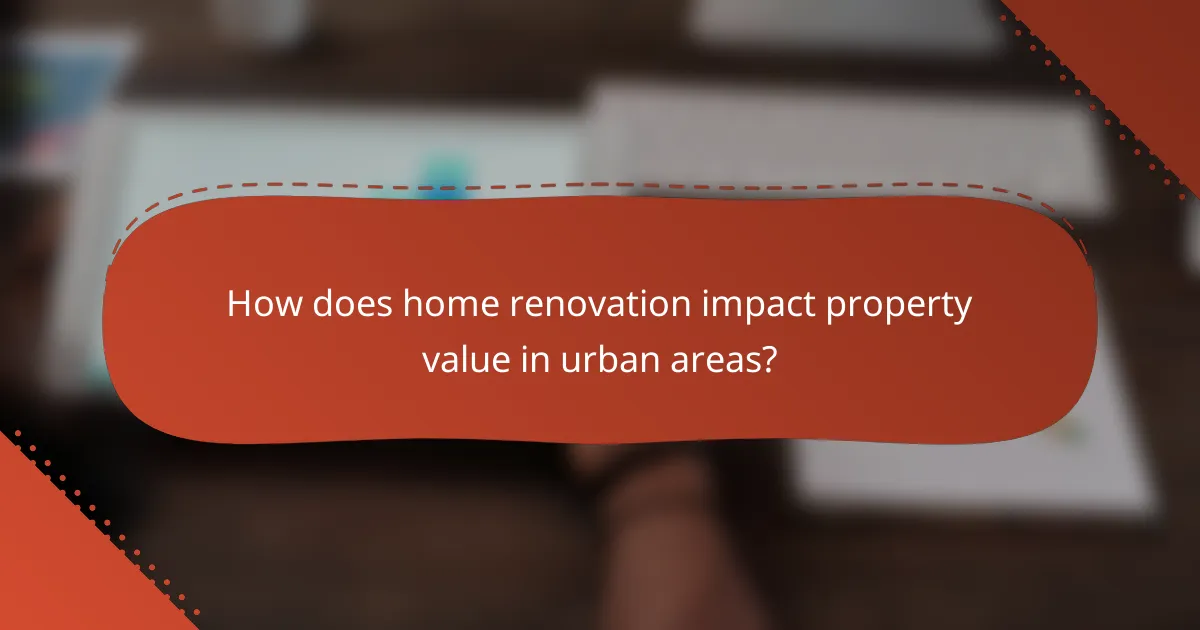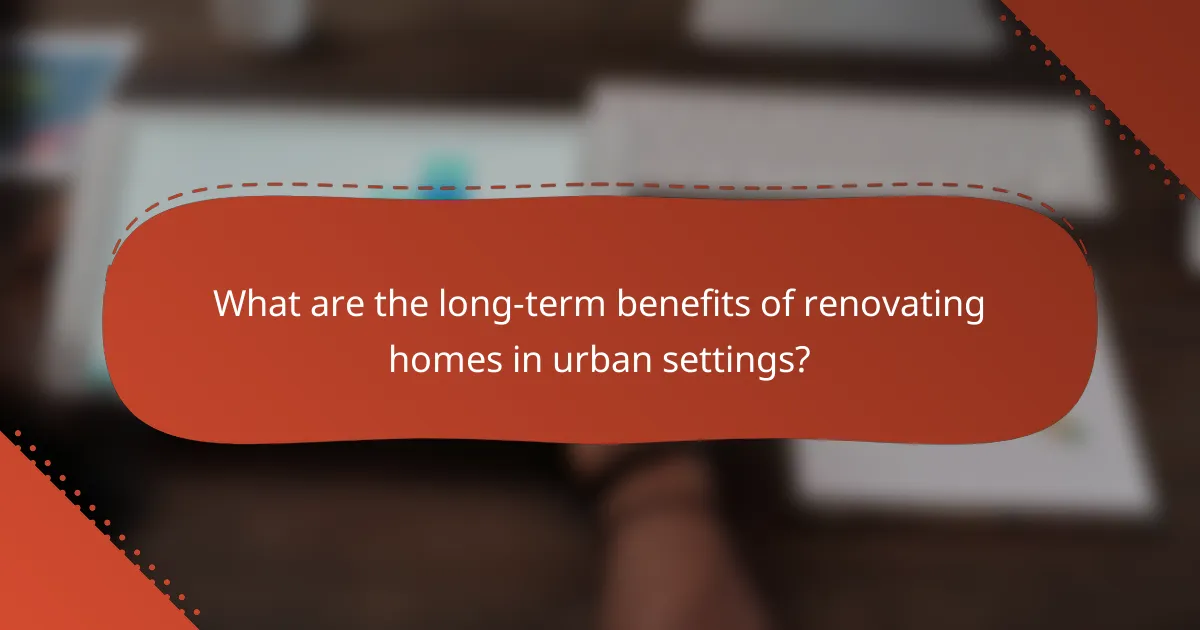Home renovation in urban areas can lead to a substantial increase in property value by enhancing both aesthetics and functionality. By focusing on cost-effective upgrades, such as kitchens and bathrooms, homeowners can attract more buyers and maximize their return on investment while staying within budget.

How does home renovation impact property value in urban areas?
Home renovation can significantly enhance property value in urban areas by improving aesthetics and functionality. Upgrades often lead to increased market demand, making properties more attractive to potential buyers.
Increased market appeal
Renovations can elevate the overall market appeal of a home, making it stand out in a competitive urban environment. Features such as modern kitchens, updated bathrooms, and energy-efficient systems are particularly appealing to buyers.
Investing in curb appeal through landscaping or exterior improvements can also attract attention, as first impressions are crucial in urban real estate markets. Simple upgrades like fresh paint or new siding can yield substantial returns.
Higher resale prices
Homes that have undergone renovations typically command higher resale prices compared to similar properties that have not been updated. In urban areas, where demand often outstrips supply, well-renovated homes can sell for tens of percent more than their unrenovated counterparts.
For instance, a kitchen remodel might recoup a significant portion of its cost upon sale, making it a wise investment. Homeowners should consider local market trends to determine which renovations are most likely to yield the best returns.
Attracts potential buyers
Renovated homes are more likely to attract a wider pool of potential buyers, including first-time homeowners and investors looking for rental properties. In urban settings, where buyers often seek move-in ready options, renovations can make a property more appealing.
Additionally, features such as open floor plans and updated amenities can cater to modern lifestyles, further increasing interest. Homeowners should focus on renovations that align with current buyer preferences to maximize attractiveness.

What are the most cost-effective renovations for urban homes?
Cost-effective renovations for urban homes typically focus on areas that yield the highest return on investment, such as kitchens, bathrooms, and energy-efficient upgrades. These improvements not only enhance livability but also increase property value in competitive urban markets.
Kitchen upgrades
Kitchen upgrades are among the most impactful renovations for urban homes. Simple changes like updating countertops, installing new cabinets, or adding modern appliances can significantly boost both functionality and aesthetics. Homeowners can expect a return on investment of around 70-80% for these enhancements.
Consider focusing on open layouts or adding an island to improve flow and usability. Even minor updates, such as new fixtures or a fresh coat of paint, can make a substantial difference without breaking the bank.
Bathroom remodels
Bathroom remodels are another effective way to increase home value. Upgrading fixtures, replacing tiles, or improving lighting can create a more inviting space. On average, homeowners can see a return of about 60-70% on bathroom renovations.
Keep in mind that maximizing space is crucial in urban settings. Consider features like floating vanities or built-in storage to enhance functionality while maintaining a sleek design.
Energy-efficient improvements
Energy-efficient improvements not only lower utility bills but also attract environmentally conscious buyers. Upgrades such as installing energy-efficient windows, adding insulation, or upgrading HVAC systems can yield returns of 50-75% depending on the extent of the improvements.
Look for local incentives or rebates that can offset initial costs. Prioritize improvements that align with local climate needs, such as cooling solutions in warmer areas or heating upgrades in colder climates, to maximize both comfort and value.

How can homeowners budget for renovations in cities?
Homeowners in urban areas can effectively budget for renovations by understanding their financial limits, prioritizing essential upgrades, and exploring financing options. This approach ensures that investments enhance property value while staying within a manageable financial framework.
Set a clear budget
Establishing a clear budget is the foundation of any renovation project. Start by assessing your current financial situation, including savings and income, to determine how much you can allocate without straining your finances. A typical range for home renovation budgets in cities might be between 5% to 15% of your home’s value.
Include all potential costs in your budget, such as materials, labor, permits, and unexpected expenses. It’s wise to set aside an additional 10% to 20% as a contingency fund to cover any surprises that may arise during the renovation process.
Prioritize renovations
Identifying which renovations will provide the most value is crucial. Focus on upgrades that enhance functionality and appeal, such as kitchen remodels, bathroom updates, or energy-efficient installations. In urban settings, curb appeal can significantly impact property value, so consider exterior improvements as well.
Rank your renovation projects based on necessity and potential return on investment (ROI). For instance, kitchen and bathroom renovations typically yield higher returns compared to other projects. A simple checklist can help you prioritize effectively:
- Essential repairs (roof, plumbing)
- High ROI upgrades (kitchen, bathroom)
- Aesthetic improvements (landscaping, painting)
Consider financing options
Exploring financing options can help homeowners manage renovation costs more effectively. Traditional methods include home equity loans or lines of credit, which allow you to borrow against your home’s value. Interest rates for these loans can vary, so shop around for the best terms.
Additionally, consider government programs or grants available for energy-efficient upgrades or historical renovations, which can reduce out-of-pocket expenses. Always evaluate the total cost of financing, including interest and fees, to ensure it fits within your overall budget.

What factors influence renovation costs in urban areas?
Renovation costs in urban areas are primarily influenced by labor costs, material availability, and permit fees. Understanding these factors can help homeowners budget effectively and maximize the value increase from their renovations.
Labor costs
Labor costs in urban areas tend to be higher than in rural regions due to the increased demand for skilled workers. Depending on the complexity of the renovation, labor can account for a significant portion of the total budget, often ranging from 30% to 50% of the overall costs.
Homeowners should consider hiring local contractors who understand the market rates and can provide competitive pricing. Obtaining multiple quotes can help ensure a fair price and avoid overpaying for labor.
Material availability
Material availability can greatly affect renovation costs in urban areas. Limited space and high demand often lead to increased prices for common materials such as lumber, drywall, and fixtures. Homeowners may find that sourcing materials locally can save on transportation costs, but they should be prepared for potential delays.
It’s advisable to plan renovations during off-peak seasons when material prices may be lower. Additionally, considering alternative materials or local suppliers can help manage costs effectively.
Permit fees
Permit fees are another critical factor influencing renovation costs in urban areas. These fees can vary widely based on the type of renovation and local regulations, sometimes ranging from a few hundred to several thousand dollars. Homeowners should research the specific requirements for their projects to avoid unexpected expenses.
Applying for permits early in the renovation process can prevent delays and additional costs. Consulting with a contractor familiar with local regulations can streamline this process and ensure compliance with all necessary codes.

How do neighborhood trends affect renovation value?
Neighborhood trends significantly influence the value of home renovations. Factors such as gentrification, local amenities, and school district quality can either enhance or diminish the return on investment for renovation projects.
Gentrification impacts
Gentrification often leads to increased property values as wealthier individuals move into a neighborhood. Home renovations in these areas can yield higher returns due to rising demand for updated properties. However, it’s essential to consider the pace of gentrification; rapid changes may lead to displacement of long-term residents and potential backlash.
Investors should evaluate the long-term sustainability of gentrification trends. Engaging with local community groups can provide insights into neighborhood dynamics and help gauge whether renovations will align with future growth or face resistance.
Local amenities
Proximity to local amenities such as parks, shops, and public transportation can significantly boost a property’s value post-renovation. Homebuyers often prioritize access to these conveniences, making homes in well-serviced areas more attractive. Renovating a home to enhance its appeal in relation to nearby amenities can lead to a substantial increase in market value.
Consider adding features that cater to lifestyle preferences, such as outdoor spaces or modern kitchens, to align with local demands. Conducting market research on what amenities are most valued in your area can guide your renovation decisions effectively.
School district quality
The quality of local school districts is a major factor influencing home values, especially for families. Homes located in districts with high ratings often see a significant increase in value after renovations. Investing in properties within reputable school zones can yield better returns compared to those in lower-rated districts.
When planning renovations, consider how improvements can enhance family-friendly features, such as additional bedrooms or play areas. Researching school performance metrics can help you understand the potential impact on property value and guide your renovation strategy.

What are the long-term benefits of renovating homes in urban settings?
Renovating homes in urban areas can significantly increase property values, enhance living conditions, and contribute to neighborhood revitalization. These improvements often lead to a better quality of life for residents and can yield substantial returns on investment over time.
Increased Property Value
One of the primary long-term benefits of home renovation in urban settings is the increase in property value. Upgrading kitchens, bathrooms, and energy efficiency can elevate a home’s market appeal, often resulting in appreciation rates that exceed the average for the area.
For instance, a well-executed kitchen remodel might yield a return on investment of around 60-80% in urban markets. This means that homeowners can recoup a significant portion of their renovation costs when selling their property.
Enhanced Living Conditions
Renovations can greatly improve the comfort and functionality of urban homes. Updating outdated systems, such as plumbing and electrical, not only enhances safety but also increases energy efficiency, leading to lower utility bills.
Moreover, modernizing spaces to better suit contemporary lifestyles—like creating open floor plans or adding outdoor living areas—can make homes more enjoyable and livable, attracting families and professionals alike.
Neighborhood Revitalization
Home renovations contribute to the overall revitalization of urban neighborhoods. As individual homes improve, they can inspire surrounding properties to follow suit, leading to a collective enhancement of the area.
This ripple effect can foster a sense of community pride and attract new businesses, which further boosts local economies. Cities often see increased tax revenues from these improvements, which can be reinvested into public services and infrastructure.
